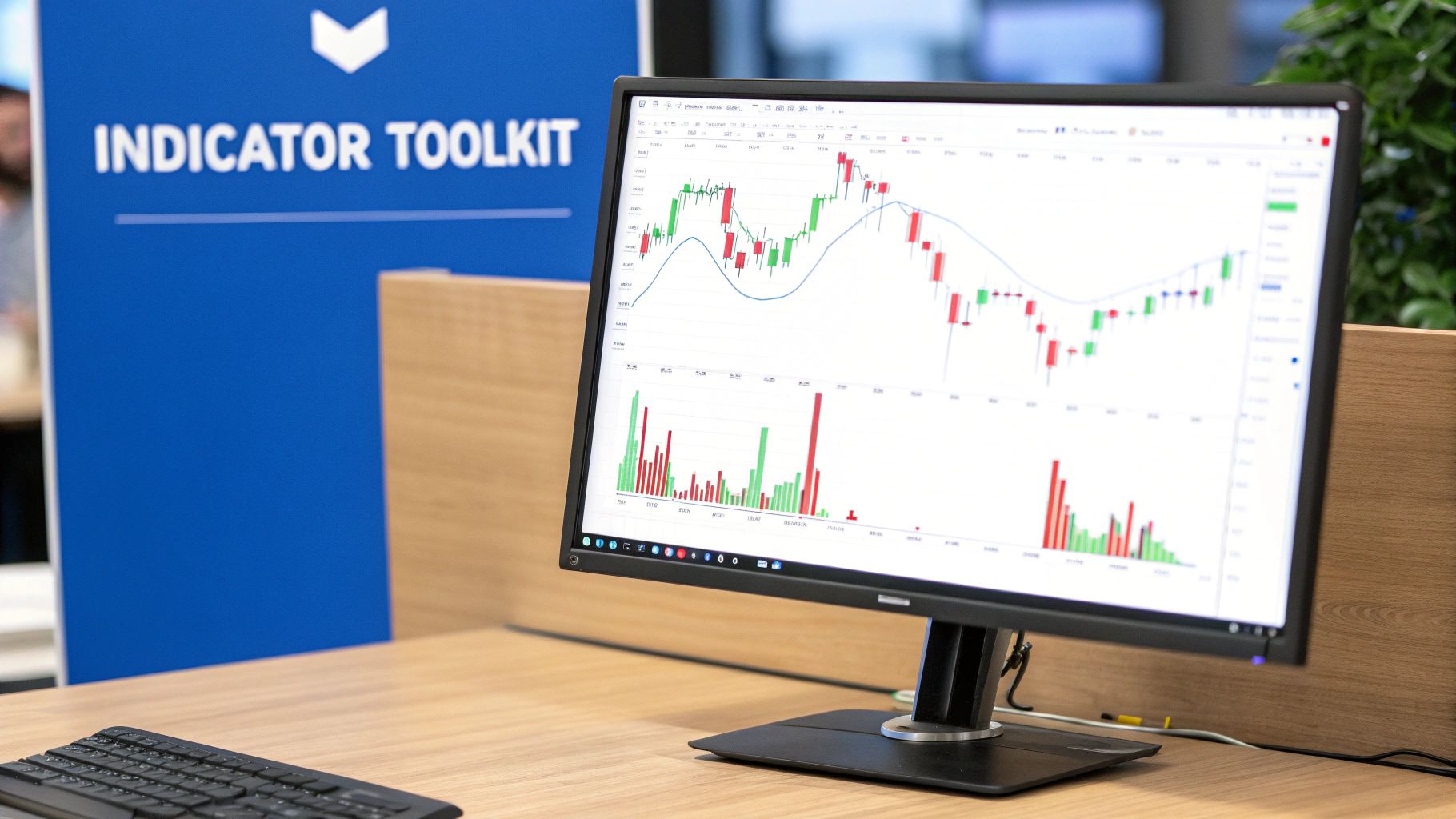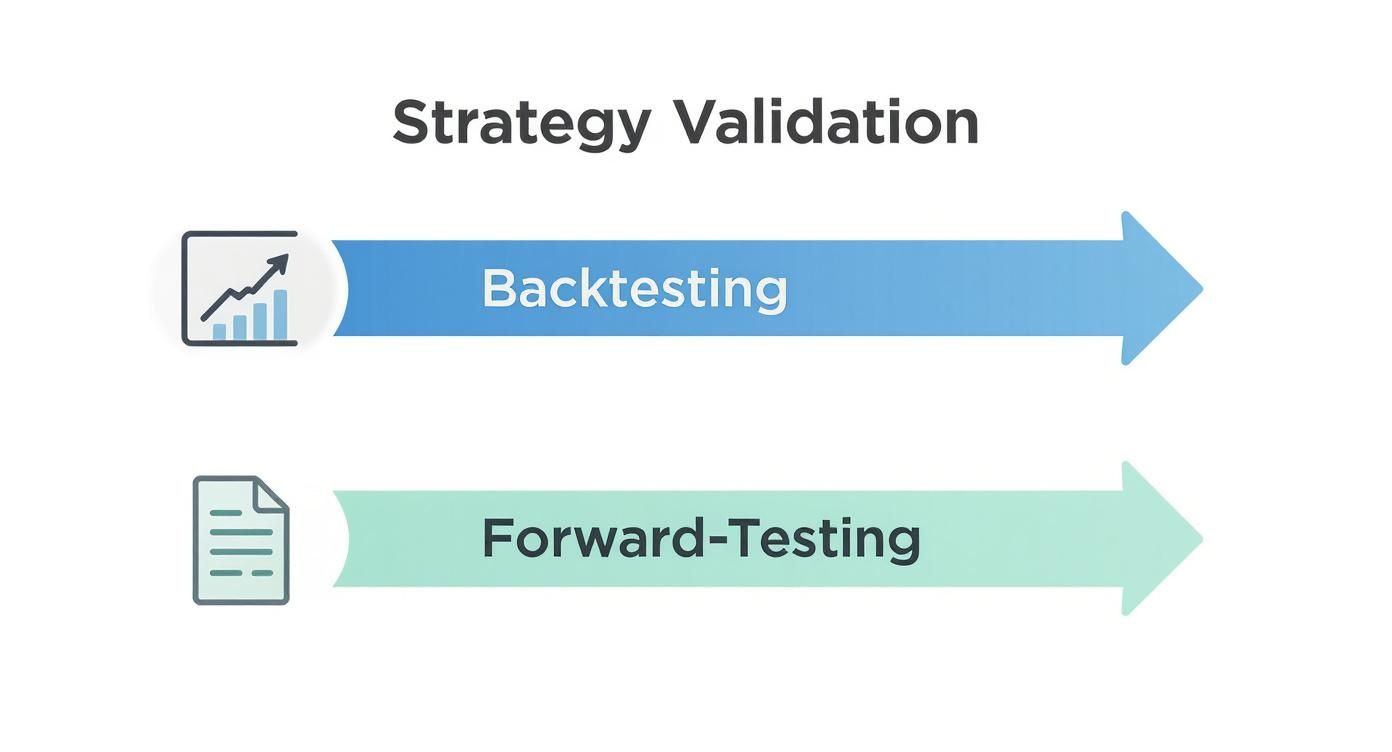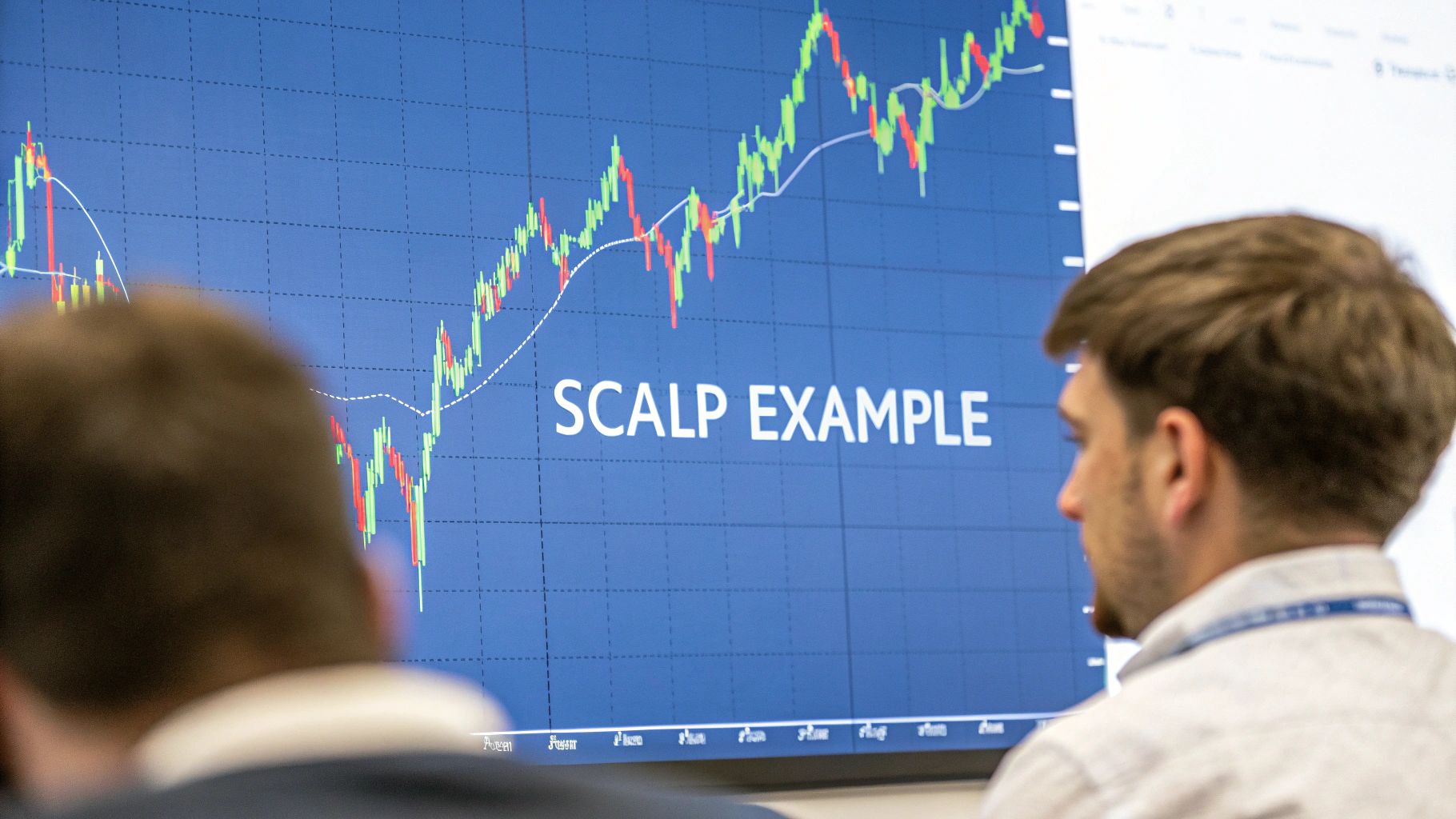Your Guide to a Scalping Trading Strategy
Ever heard of a scalping trading strategy? It’s not for the faint of heart. Imagine executing a massive volume of trades, sometimes dozens or even hundreds in a single day, all to capture tiny slivers of profit from the smallest price flickers. We're talking about getting in and out of the market in mere seconds or minutes.
It's an intense, lightning-fast method where traders bank on the law of large numbers. The goal isn't to hit a home run; it's to get a whole bunch of base hits. These small, consistent gains, when piled up, can amount to a significant profit by the end of the session. This style demands unwavering focus and the ability to make split-second decisions without hesitation.
Decoding the Scalper Mindset

To really get what a scalping trading strategy is all about, picture a hummingbird flitting from flower to flower. It doesn’t drain one flower dry; instead, it takes a quick sip and immediately zips off to the next one. A scalper operates just like that, darting between trades to skim small, predictable profits from the market's constant, minor movements.
This approach is the complete opposite of long-term, buy-and-hold investing. Scalpers couldn’t care less about a company’s quarterly earnings report or its five-year growth plan. Their entire universe is confined to one-minute or five-minute charts, where they thrive on the market's inherent "noise."
The Scalper Personality Profile
Let's be clear: not everyone is cut out for this high-octane environment. Success in scalping demands a very specific psychological makeup. You have to be incredibly disciplined, ruthlessly decisive, and almost robotic in your emotional detachment from any single trade. There’s simply no time for second-guessing or dwelling on a small loss. Decisions are made in a flash.
The core philosophy of scalping is not about hitting home runs. It's about consistently getting on base with small, predictable hits. The goal is to build a high win rate, where the sum of many small profits outweighs the inevitable small losses.
This constant engagement means a scalper is practically glued to their screen, watching every single tick and price change with laser-like focus. It’s a mentally exhausting style that requires you to be at the top of your game, but only for short, concentrated bursts of time.
Scalping vs Traditional Day Trading
It's a common point of confusion, but while all scalpers are technically day traders, not all day traders are scalpers. Scalping is a super-specialized niche within day trading, defined by its extreme speed and trade frequency.
To make the distinction crystal clear, here’s a quick breakdown of how they differ.
Scalping vs Traditional Day Trading Key Differences
This table highlights the core differences between a scalping approach and a more traditional day trading style, showing just how unique the demands of scalping really are.
| Attribute | Scalping | Traditional Day Trading |
|---|---|---|
| Trade Duration | Seconds to a few minutes | Minutes to several hours |
| Profit Targets | Very small (e.g., 5-10 pips) | Larger (e.g., 20-100 pips) |
| Risk Per Trade | Extremely tight and small | Moderate, based on chart patterns |
| Screen Time | Intense, continuous focus | Active monitoring, but with breaks |
| Number of Trades | High volume (10s to 100s per day) | Low volume (1-5 per day) |
As you can see, their methodologies are worlds apart. A classic day trader might spend an hour analyzing a chart setup before entering a position they intend to hold for the rest of the afternoon. In that same hour, a scalper might have already executed a dozen trades.
However, it's crucial to approach this with a dose of reality. The vast majority of retail scalpers find it incredibly difficult to stay profitable long-term, thanks to razor-thin margins that get eaten up by transaction costs. Broker reports and academic studies consistently show that around 70–80% of all day traders, scalpers included, lose money over time. You can dig into more data on scalping trading profitability to understand the steep challenges. This sobering statistic hammers home the need for an ironclad strategy, flawless execution, and world-class risk management.
Finding the Right Markets for Scalping
Picking the right market is just as crucial as mastering your technique. A scalping trading strategy performs best where conditions are smooth and fast—think of it like a speedboat that needs a wide, calm lake.
To succeed, you want two main ingredients: high liquidity and low volatility. Liquidity ensures there are plenty of buyers and sellers so you can enter and exit instantly without worrying about slippage. Low volatility means prices move in small, predictable waves rather than sudden spikes.
Locating High-Liquidity Hunting Grounds
Some markets naturally fit scalping’s demands better than others. Look for assets that trade in huge volumes every day.
- Major Forex Pairs: EUR/USD, GBP/USD and USD/JPY handle millions of dollars every minute, so your orders glide right through.
- High-Volume Stocks and ETFs: Names like AAPL or SPY keep the order book thick, letting you zoom in and out of positions.
- Major Index Futures: E-mini S&P 500 futures are a favorite among pros for their deep liquidity and steady price action.
Trying to scalp thinly traded penny stocks? You’ll feel like you’re paddling upstream through rapids—inefficient and risky.
The Hidden Killer of Scalping Profits
Even in the perfect market, transaction costs can erode your edge. When you’re firing off dozens or hundreds of trades daily, tiny fees add up quickly.
In scalping, the bid-ask spread and commissions aren't minor expenses; they are the primary barrier to profitability. Overcoming these costs on every single trade is the fundamental challenge of the strategy.
Say your target is a 5-pip gain. If the spread is 1 pip and commissions cost another 1 pip, you now need 7 pips just to break even. That makes your goal 40% harder right out of the gate.
Choosing a broker with razor-thin spreads and minimal commissions isn’t optional—it’s the difference between a winning system and one that bleeds money over time.
Timing Your Trades For Peak Activity
Even the best markets sleep at times. Scalpers want action, so you need to trade when participation is at its highest.
The sweet spot for forex and futures often comes with the overlap of the London and New York sessions—roughly 8:00 AM to 12:00 PM EST.
- Massive Trading Volume: Two major financial centers are live, and liquidity spikes.
- Tighter Spreads: Competition between liquidity providers narrows the bid-ask gap.
- Consistent Price Action: News and data releases tend to drive steady, small trends you can follow.
Outside these hours, it feels like fishing in a still pond—orders go unfilled, spreads widen and scalping opportunities dry up.
Essential Indicators For Your Scalping Toolkit

Scalping isn’t about throwing every indicator at the wall and hoping something sticks. It’s more like a race car cockpit—only the gauges you truly need are in view. Strip away complexity and focus on a handful of fast-responding tools that highlight trend, momentum, and volatility in real time.
By blending just three core indicators, you’ll cut through the noise and spot high-probability entries and exits on those razor-thin 1-minute or 5-minute charts. Let’s break down how to build this lean toolkit.
Riding The Trend With Exponential Moving Averages
Your go-to trend filter is the Exponential Moving Average (EMA). Unlike its simple cousin (SMA), the EMA weights fresh price data more heavily—crucial when every second counts.
A classic scalping setup uses two EMAs:
- Fast EMA (9-period): Reacts almost instantly to price swings
- Slow EMA (21-period): Confirms the dominant trend
When the 9-period EMA crosses above the 21-period, you’re seeing bullish momentum—time to look for buys. A drop below signals bearish pressure and a potential short.
On a 5-minute chart of a liquid asset, waiting for the price to pull back toward these EMAs often yields crisp, trend-aligned entries.
Gauging Momentum With The Relative Strength Index
Once you’ve locked in trend direction, you need to catch retracements before they end. Enter the Relative Strength Index (RSI), oscillating between 0 and 100.
Key RSI thresholds for scalping:
- Overbought (> 70): Signals potential exhaustion on a rapid rally
- Oversold (< 30): Flags possible end of a sharp drop
In practice:
- In an uptrend (price above EMAs): look for RSI to dip into the 30–40 range—an early buy cue
- In a downtrend (price below EMAs): watch RSI rally into 60–70—a warning that bounce could be fading
The RSI doesn’t just mark extremes; it times your entry by revealing when a quick pullback is spent and the main trend is poised to resume.
Measuring Volatility With Bollinger Bands
Finally, think of Bollinger Bands as your volatility gauge. A central 20-period SMA sits in the middle, flanked by bands set at two standard deviations.
Scalping tactics with Bollinger Bands:
- Wide bands = high volatility = more swing potential
- Narrow bands = low volatility = consider sitting out
- Entry near one band, profit target at the opposite band
By combining EMA trend, RSI timing, and Bollinger band range, you’ll have a complete, high-probability setup.
Master these three and you’ll cut through market chatter with confidence. For a deeper dive into complementary tools, check out our guide on the best day trading indicators to watch in 2025 right here at ChartsWatcher.
Mastering Risk in High-Frequency Trading
Let’s be honest. In the world of scalping, the adrenaline rush from speed and precision is what draws most people in. But that’s not what keeps you in the game. Your actual lifeline? Risk management.
Mastering this skill is the single biggest factor that separates the consistently profitable scalpers from those who blow up their accounts in a flash. Think of your trading capital less like ammunition and more like your oxygen tank—once it’s gone, the journey is over. A winning scalping trading strategy is built first and foremost on preserving capital, not just chasing profits.
Big wins are exciting, no doubt. But the sheer volume of trades you’ll be making means a few oversized losses can wipe out dozens of successful trades in the blink of an eye. Your primary job isn't to make money; it's to protect the money you already have.
The Non-Negotiable 1 Percent Rule
The absolute cornerstone of risk management in scalping is the 1% rule. The principle is brutally simple but completely non-negotiable: you never, ever risk more than 1% of your total account balance on a single trade. If you have a $5,000 account, your maximum loss on any given trade is just $50. Period.
That might sound ridiculously small, but it's your only real defense against a nasty losing streak. Scalping means placing hundreds, if not thousands, of trades. It's a statistical certainty that you will face a string of consecutive losses. Risking 5% or 10% per trade feels like a shortcut to bigger gains, but it’s actually an express lane to a zero balance.
Imagine a firefighter arriving at a small blaze. Their first move isn't to save the whole building; it's to contain the fire and prevent it from spreading. As a scalper, you are a financial firefighter. Your job is to cut losing trades instantly and without hesitation to prevent a small, manageable loss from turning into an account-destroying inferno.
Sticking to the 1% rule means you can absorb a dozen or more losses in a row and still have plenty of capital left to keep trading your strategy. It shifts trading from a high-stakes gamble to a game of probabilities, giving you the staying power to let your statistical edge work its magic over time.
Taming Your Trading Psychology
Even with a perfect set of rules, your biggest enemy is often staring back at you in the mirror. The rapid-fire nature of scalping creates a pressure-cooker environment where emotional decisions can cause absolute chaos. Two of the most lethal psychological traps for scalpers are revenge trading and the fear of missing out (FOMO).
Revenge trading is what happens right after a frustrating loss. You feel like the market "owes you," so you immediately jump back in—usually with a bigger position size—abandoning your plan to claw back your money. This almost always ends in disaster.
FOMO is just as bad. You see a price ripping higher and impulsively chase it, entering late and without a valid setup because you're terrified of missing out on the profit. These trades are almost always entered at the worst possible price, right as the move is getting ready to reverse.
To fight these impulses, you need to build unflinching discipline. Here are a few practical ways to do it:
- Take a Mandatory "Cool-Down" Period: If you hit three consecutive losing trades, step away from the screen. No exceptions. Go for a walk, grab a coffee, do anything for at least 15 minutes. This simple act breaks the emotional spiral and stops you from digging a deeper hole.
- Use a Physical Checklist: Before you even think about clicking the "buy" or "sell" button, you must be able to physically tick off every single condition in your trading plan. If even one box is unchecked, you don't take the trade.
- Set a Daily Loss Limit: Decide ahead of time the absolute maximum you're willing to lose in one day (say, 2-3% of your account). The moment you hit that limit, you shut down your platform and walk away. This is your circuit breaker, and it will save you from a catastrophic day.
By embedding these hard rules into your routine, you create a protective framework around yourself. It keeps your own worst instincts at bay and ensures your scalping trading strategy remains a disciplined business, not an emotional rollercoaster.
Validating Your Strategy Before You Trade
Jumping into the live market with an untested scalping strategy is the financial equivalent of flying blind. It's a rookie mistake, and a costly one. Before you risk a single dollar, you absolutely must put your system through a rigorous validation process to prove it has a genuine statistical edge.
Think of this process as your pre-flight check. It's designed to build unshakeable confidence in your method before you take off.
The path to a validated strategy involves two critical stages: backtesting and forward-testing. Backtesting is like studying historical flight plans—you're looking at past data to see if your plane (your strategy) would have navigated the route successfully. Forward-testing, on the other hand, is like running a hyper-realistic flight simulation. You're flying in real-time market conditions but with fake money.
This graphic breaks down the essential two-step flow for validating any high-frequency trading system.

As you can see, historical analysis (backtesting) must always be followed by live simulation (forward-testing) to confirm a strategy's real-world viability. Don't skip a step.
The Unique Challenges of Testing a Scalping Strategy
Here's the thing: testing a scalping strategy isn't as simple as running a standard backtest. The sheer frequency of trades makes the system extremely sensitive to tiny variables that longer-term strategies can often ignore. If you don't simulate these factors accurately, your results will be useless.
In scalping, transaction costs aren't a minor detail; they are a core component of the strategy itself. A system that looks wildly profitable before costs can easily become a consistent loser once spreads, commissions, and slippage are factored in.
Your testing has to account for the real-world friction of trading:
- Spreads: The bid-ask spread is a cost you pay on every single trade. No exceptions.
- Commissions: Those brokerage fees add up lightning-fast over hundreds of daily trades.
- Slippage: The difference between the price you thought you'd get and the price you actually get can completely torpedo a trade's outcome.
Failing to model these costs precisely will give you a dangerously optimistic—and false—view of your strategy's performance. That's why it's so important to learn how to backtest a trading strategy the right way to confirm you actually have a statistical edge.
Backtesting and Forward-Testing in Practice
Backtesting is where you start. Using historical chart data, you manually or automatically apply your strategy's rules to see how it would have performed over weeks, months, or even years. The goal is to gather hard data on key metrics like win rate, average profit per trade, and maximum drawdown.
For a deeper dive into this crucial first step, check out our comprehensive guide on how to backtest trading strategies like a pro.
Once you have promising backtesting results, you move to forward-testing, also known as paper trading. This is where the rubber meets the road. You trade your strategy on a demo account using a live market data feed, testing your ability to execute under real-time pressure and revealing performance quirks that historical data could never capture.
Simulation results can be a sobering wake-up call. For example, one recent experiment showed a strategy generating a $10,000 one-day gain on one simulated feed, only to lose nearly $1,200 on another. It highlights just how sensitive these systems are.
Only after a strategy proves consistently profitable in both backtesting and an extended period of forward-testing should you even think about trading it with real money.
A Step by Step Scalping Trade Example

Theory is great, but nothing makes these concepts click like seeing a scalping trading strategy play out in real time. Let’s walk through a hypothetical trade from start to finish. We'll be watching a 1-minute chart of the EUR/USD, a favorite playground for scalpers because of its deep liquidity and razor-thin spreads.
For this breakdown, we'll use the indicators we've already covered: a 9-period EMA, a 21-period EMA, the RSI, and Bollinger Bands. I’ll explain the "why" behind every decision, giving you a clear blueprint to follow.
Step 1 Identifying the Setup
First things first, what's the market's immediate mood? A quick glance at our moving averages on the 1-minute chart shows the faster 9-period EMA is cruising comfortably above the slower 21-period EMA. That's our green light—a bullish short-term trend is in play, so we’re only hunting for buy opportunities.
At the same time, I'm noticing the price has pulled back and is kissing the lower Bollinger Band. This is a classic signal that the price might be a bit overextended to the downside within the bigger uptrend. It's essentially the market flashing a "buy the dip" signal on a micro scale, offering a potential bargain entry.
Step 2 Pinpointing the Entry
Okay, the trend is up and we've got our pullback. Now, we look to the RSI for the final confirmation. Just as the price tags that lower Bollinger Band, the RSI dips to around 35. It's not in the deep "oversold" basement, but it’s low enough to tell us the downward push is running out of steam.
The second we see a bullish candle start to form and the price bounces off that lower band, that's our trigger. It’s the combination of all three signals—the EMA-confirmed uptrend, the price at a support level (the lower band), and the RSI turning upwards—that gives us the confidence to pull the trigger.
We jump in with a buy order at 1.0855.
Step 3 Defining Your Risk and Reward
Before we even think about the potential profit, we lock down our exits. In scalping, this isn't just a good idea; it's a non-negotiable rule etched in discipline.
Here’s how we manage the risk on this trade:
- Set the Stop-Loss: We place our stop-loss just underneath the recent swing low, right at 1.0850. This gives us a tiny risk of just 5 pips. If the trade turns sour, our loss is capped and we live to fight another day.
- Set the Take-Profit: Our primary target is the upper Bollinger Band, which is hovering around 1.0865. This gives us a potential reward of 10 pips.
This setup creates a clean 2:1 risk-to-reward ratio. For every dollar we're putting on the line, we stand to make two. A positive ratio like this is absolutely critical for any sustainable scalping strategy.
Step 4 Managing the Live Trade
The trade is on. We watch as the price springs off the lower band and heads north, just like our indicators suggested it would. Within three minutes—that's just three candles on our 1-minute chart—the price rallies and hits our take-profit target at 1.0865.
Our platform automatically closes the position, banking a 10-pip profit. The entire operation, from spotting the setup to cashing out, took less than five minutes.
This example is the essence of scalping: identify a high-probability setup, set iron-clad risk parameters, and snatch a small, quick profit before the market has a chance to change its mind.
A Few Common Questions About Scalping
Even with a solid game plan, diving into the fast-paced world of scalping can feel like jumping onto a moving train. It's totally normal to have a few questions rattling around. Let's tackle some of the most common ones to clear the air.
Getting straight answers to these practical concerns is a huge step toward building a realistic and effective scalping trading strategy.
How Much Capital Do I Need To Start Scalping?
Technically, you can open an account with a few hundred bucks, but trying to scalp with that is like fighting with one hand tied behind your back. A much more realistic starting point is somewhere between $1,000 to $5,000.
Why that much? Because it gives you a necessary cushion to handle the inevitable losing streaks without blowing up your account. More importantly, it lets you actually apply the 1% risk rule on your trades without being dangerously over-leveraged. With a tiny account, your transaction costs alone can eat you alive.
Is Scalping More Profitable Than Swing Trading?
Not necessarily. Profitability really comes down to the trader's skill and personality, not the strategy itself. Scalping is all about racking up a high volume of small wins. Swing trading, on the other hand, is about catching fewer, but much larger, moves.
One style isn't inherently better; it’s all about finding the one that clicks with you. For many traders, the lower stress and reduced transaction costs of swing trading actually lead to higher net profits over time.
While a scalper might enjoy the feeling of frequent small wins, those high commission costs can take a serious bite out of the final tally.
Can I Scalp Trade Using My Phone?
You can, but you really, really shouldn't. Trying to seriously scalp from a mobile device is setting yourself up for failure. The strategy demands lightning-fast analysis and precision that a mobile interface just can't deliver.
Think about it—it's nearly impossible to watch multiple charts, apply indicators, and manage your orders with the speed you need on a tiny screen. There's a reason the pros use multi-monitor desktop setups. It’s all about minimizing costly mistakes and grabbing those split-second opportunities.
Ready to put your strategy into action with professional-grade tools? ChartsWatcher gives you the advanced scanning, real-time data, and customizable charting you need to spot opportunities with precision. Build your edge with ChartsWatcher today.

